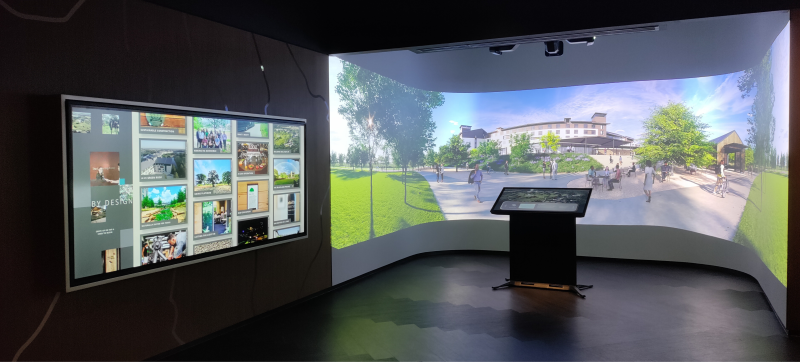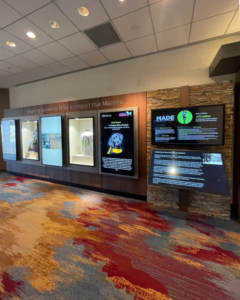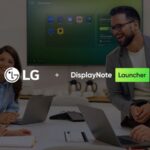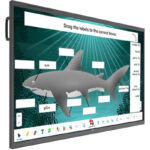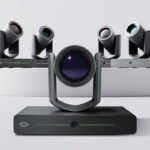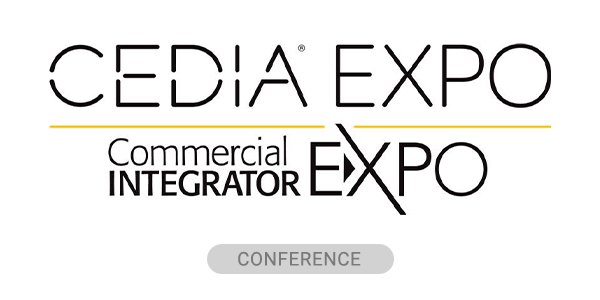For global enterprises, a strong visual communications strategy is key to building community and identity. However, implementation requires technology that is flexible enough to adapt to specific local needs and shifting corporate requirements. In other words, building an effective visual communications application for a global enterprise requires not just a project but a partnership. Global enterprises need service providers who can help them continuously expand, update and evolve applications so that the technology matches the nimbleness and innovation of the firm.
As a case in point, let’s examine a top-five global consulting firm (referred to here as “the client”) that has worked to bring modern visual communications solutions to three flagship locations in Fort Worth, Texas; Hyderabad, India; and Paris, France. Each location had unique, shifting demands, necessitating a unique mix of large-scale visual experiences managed by a single unified content management system. The solution needed to do the following:
- Be responsive and customizable to each region’s needs.
- Maintain branding consistency and corporate identity across locations.
- Handle a range of large-scale experiences and integrations with ease.
This project proves that how you approach the project scope is just as critical as the deliverables themselves — opening the opportunity for greater usability, more impactful results and opportunities for future collaboration. With this in mind, here are some valuable lessons that AV integrators can leverage to differentiate their business and deploy effective AV projects on a global scale.
Lesson One: Think Globally but Design Locally
This project emphasized the importance of localized content control within enterprise-level parameters — both physically and culturally. Each location has some assets, applications and content that are unique to that site.
For example, the client’s Fort Worth and Hyderabad locations house training campuses, requiring comprehensive, multi-functional visual communications solutions designed to engage visitors and staff. These include:
- Sitewide digital signage
- Interactive videowalls
- Mobile wayfinding
- Multi-functional room scheduling
All told, these two sites have nearly 250 endpoints with different applications, orientations and designs, as well as a dedicated cloud-hosted environment.
The Fort Worth location also had two unique standout features: A large-scale videowall and immersive experience center designed by the renowned architectural firm Gensler and AVI-SPL’s XTG Experience Technology Group. To offer an immersive, dynamic brand experience and maximize engagement, the project integrated multi-touch interactivity for the videowall. The experience center featured three distinct experiences: a touchscreen highlighting the client’s portfolio of solutions; a topographic map with projection-mapped features; and a 180-degree projector with touch-table-based interactive triggers.
Meanwhile, the Paris location was designed to be less of a customer-facing campus and more of a structured corporate environment. Due to the different nature of the campus, the client needed a streamlined solution with 25 space booking endpoints for hot desking and room reservation, eight wayfinders and a web-based wayfinding mobile app. From a cultural standpoint, the Paris staff also preferred a more minimalist interface than the US- and India-based staff.
Once these deployments were completed using a single unified system, expanding the same CMS to Paris was cost-effective and efficient: The customizable platform made it simple to eliminate some of the more intricate design elements used in Hyderabad and Fort Worth and deliver a simple, streamlined room booking experience. Using a single unified CMS helped the client accelerate the project timeline for its Paris location, enabling the new campus to reuse branding, templates, widgets and content from the previous deployments and slashing development costs.
Accommodating the unique demands of each site meant creating both global content standards and localized content with site-specific editing permissions and approval workflows. This ensured that each site would meet its objectives, accommodate cultural nuances and feel true ownership over the content management system. At the same time, the client had the centralized management tools it needed to maintain overall brand identity.
Lesson Two: Find Ways to Say ‘Yes’ to Existing Tools
Working with a global brand requires a lot of flexibility. You won’t necessarily be in a position to specify your preferred hardware or offer direction on your client’s enterprise software strategy. Depending on the organization’s IT policies, you may find entirely different room standards across locations. This is especially true for global organizations where local regulations and incentives may impact site-specific hardware selection. As a result, it is critical to specify solutions that play nicely with various platforms and manufacturers.
In this case, while some of the client’s goals overlapped across sites, each project required a different mix of new and existing hardware. Flexible integration has remained key to the project’s evolution over time. The client now has the same hotdesking and room booking solutions deployed on both Cisco and Crestron room boards. Custom APIs allow the visual communications system to integrate with the client’s preferred emergency alert and room booking tools (Honeywell Emergency and Infor, respectively). Sites used a combination of BrightSign, Crestron and Cisco digital signage hardware — sometimes all three in one location. The foundation of a long-lasting relationship is the willingness to say “yes” to the client’s preferred tools and software instead of trying to steer them toward more familiar territory.
Lesson Three: Keep in Touch
This project with the client has never truly ended; regular check-ins have allowed the initial sale to evolve into new opportunities to maximize, evolve and expand visual communications experiences. The conversations include frank discussions of system efficacy, emerging needs and available feature improvements.
For example, a few years after the initial deployment, the Gensler multi-touch experience in Fort Worth proved too sophisticated for real-world use. The client observed that most users didn’t spend enough time in the experience center to explore the touchscreen’s narrative deeply. To resolve this, the client contracted a subset of the original team to streamline the storytelling, creating an experience that more people could fully explore and increasing the showpiece’s usability. The new content layout was also more straightforward for the client to update, resulting in a more future-proof design.
These regular check-ins don’t just cultivate positive word-of-mouth: they regularly create new business. Regular post-completion conversations have yielded new content design work to help the client keep their signage deployment fresh. Service hours have been added to the original contract to expand deployment to new locations, add content licenses and training hours, and ideate with the client about what else visual communication solutions could help them achieve. Currently, the wayfinding deployment in Fort Worth is being updated to add more floors and room locations as the campus expands and a UI update is on deck for Hyderabad. This is what it means to be a partner and invest in the client’s success even after the ink on signoff is dry and the last check has cleared.
Business Development Gospel
The idea that your current clients are your best sales opportunity is business development gospel. It’s doubly true of global enterprises with the vision and the budget to think big about AV technology. Your goal with these entities shouldn’t be project completion but an ongoing relationship that will drive mutual benefits for years. If you and your tools are flexible enough to adapt to both clients’ tools and standards and site-specific needs, an independent AV service provider can become a true member of a global enterprise team.
 Tomer Mann is chief revenue officer with 22Miles.
Tomer Mann is chief revenue officer with 22Miles.

